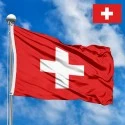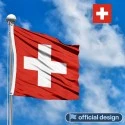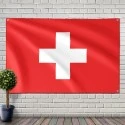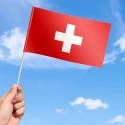The national flag of Switzerland is renowned globally for its distinctive square shape and striking simplicity: a bold, white, equilateral cross centered on a vibrant red field. This unique design sets it apart from almost all other national flags, with only the Vatican City flag sharing its square proportions. The flag is not merely a piece of cloth; it is a profound national emblem, deeply intertwined with the history, values, and identity of the Swiss Confederation. Its elegance reflects the core principles of neutrality, precision, and the renowned craftsmanship for which Switzerland is celebrated worldwide.
The dimensions of the Swiss flag are precisely defined, contributing to its iconic appearance. For the national flag, the standard proportion is square, meaning its height equals its width. The white cross itself is meticulously proportioned: its arms are equilateral, and their ratio of length to width is 7:6. Furthermore, the size of the cross in relation to the red field was formally set in 2017 at 5:8, meaning the cross spans five-eighths of the flag's width and height. The exact shade of red is also specified, known as Pantone 485 C (RGB #FF0000), a brilliant, strong red that evokes passion and vitality. The white of the cross is pure, signifying peace and integrity.
The history of the Swiss flag stretches back to the Middle Ages, with its roots firmly embedded in military and confederate symbols. The white cross on a red background first emerged as a distinguishing insignia for Swiss soldiers in the Battle of Laupen in 1339. To identify themselves amidst the chaos of battle, soldiers from the nascent Swiss Confederation sewed white crosses onto their armor or clothing. This symbol quickly gained prominence and was adopted on the banners and weapons of Swiss mercenaries, renowned throughout Europe for their discipline and effectiveness. By the 15th century, a small red flag with a white cross became a common war banner for the various cantons. The cross design itself is believed to have a Christian origin, possibly stemming from the Imperial War Flag of the Holy Roman Empire, which bore a similar emblem.
Despite its long military history, the modern national flag, in its current standardized form, is a relatively recent adoption. While the white cross on red had been recognized as a symbol of the Confederation for centuries, its official status as the national flag was not enshrined until the Federal Constitution of 1848, which formally established Switzerland as a federal state. However, the precise design and dimensions of the cross were not definitively codified until later. In 1889, a federal resolution standardized the cross, stipulating that its arms should be one-sixth longer than their width. Finally, a new law in 2017 reconfirmed the square shape for the national flag and precisely defined the proportions of the cross to the field, solidifying its place as a unique national symbol. For maritime purposes, Swiss merchant vessels are permitted to fly a rectangular version of the flag, retaining the same white cross on a red field.
The symbolism of the Swiss flag is rich and multifaceted, reflecting the nation's core values. The white cross is universally understood to represent unity, peace, and neutrality, key tenets of Swiss identity. It also subtly alludes to the nation's Christian heritage without endorsing a specific denomination, embodying religious tolerance and diversity. The vibrant red background is often interpreted as representing valor, sacrifice, and the blood shed by those who fought for Swiss freedom and independence throughout history. Beyond these historical connotations, the flag has evolved to symbolize Switzerland's commitment to humanitarianism, democracy, and decentralized governance. The cross reflects the respect and cooperation among the 26 cantons that form the Swiss Confederation, fostering a sense of collective identity despite linguistic and cultural differences.
For the inhabitants of Switzerland, the flag holds immense emotional and civic significance. It is a powerful unifying symbol, fostering a deep sense of national pride and shared identity among a diverse population speaking four national languages (German, French, Italian, and Romansh). The flag is prominently displayed on national holidays, particularly on August 1st, Swiss National Day, which commemorates the founding of the Swiss Confederacy. On this day, homes, public buildings, and even mountain peaks are adorned with the red and white emblem, celebrating the country's unity, democracy, and long-standing peace. The flag is also a visible representation of Switzerland's renowned neutrality, a cornerstone of its foreign policy that has allowed it to play a unique role in international diplomacy and humanitarian aid. It is a symbol of stability, prosperity, and a high quality of life, resonating with the Swiss people's values of diligence, precision, and community. The ubiquity of the flag, appearing on everything from official documents to everyday products, reinforces its deep cultural integration and its role as a constant reminder of Swiss heritage and values.
Interesting facts about the Swiss flag further highlight its unique character. Perhaps the most striking fact is its square shape, a rarity among national flags, shared only with the flag of Vatican City. This square form is not merely aesthetic; it is deeply rooted in the historical military banners and coats of arms that were often square. Another fascinating aspect is the subtle nuance in the German language within Switzerland: Swiss German speakers often refer to it as "Schweizerfahne" rather than "Flagge," emphasizing its unique status and historical origins. While its red color is universally recognized, the exact shade of red was only officially defined relatively recently in 2007, ensuring consistency across all representations. The precise proportions of the cross, with its arms slightly longer than their width, also contribute to its distinctive visual balance, making it instantly recognizable worldwide. The flag's simple yet powerful design has become synonymous with quality, reliability, and the humanitarian principles that Switzerland champions on the global stage, making it one of the most respected national symbols in the world.
In the demonstration images, full-size flags are shown with proportions of 2:3, and hand-held flags with proportions of 1:2.







 Waving flag
Waving flag
 Sizes:
Sizes:
 Round flag
Round flag
 Sizes:
Sizes:
 Rectangular flag 2:3
Rectangular flag 2:3
 Sizes:
Sizes: